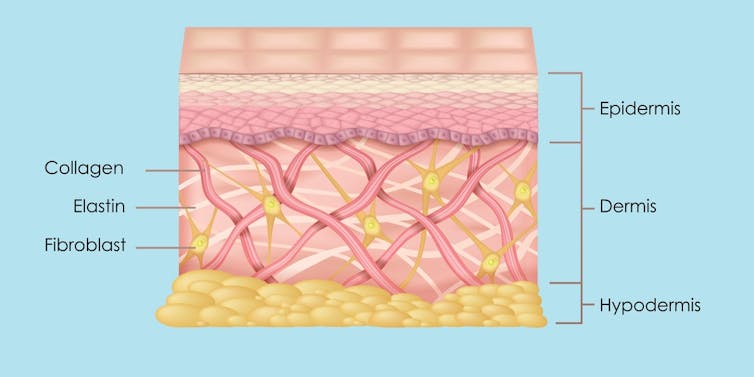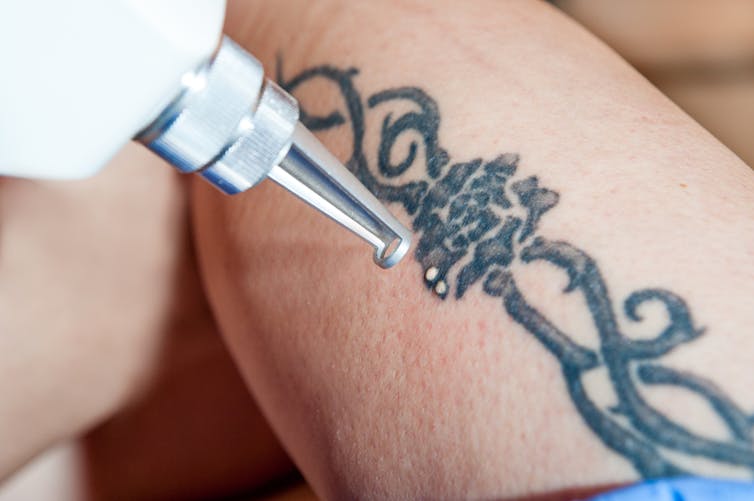Source: The Conversation (Au and NZ) – By Katie Lee, PhD Candidate, Dermatology Research Centre, The University of Queensland

About one in four people regret at least one of their tattoos. Almost half of those go on to have their unwanted tattoo removed or camouflaged with a new one.
So it’s no wonder people are searching for laser tattoo removal services.
Here’s what to consider when choosing the best clinic and what to expect when you get there.
Read more:
Thinking of a(nother) tattoo this summer? What you need to know about sunburn, sweating and fading
Why are tattoos permanent?
You can still see tattoos on the 5,300-year-old ice mummy Ötzi. That’s because tattoo artists use needles to deposit ink in the dermis, the layer of skin under the outer layer (or epidermis).
When this happens, the body recognises ink particles as “foreign”. So immune cells in the dermis, such as macrophages, take them up.
But the particles are too large for these specialised cells to break down and remove via the lymphatic system. Instead, the particles remain “locked” permanently in macrophages in the dermis.

zonn hong/Shutterstock
How do lasers remove tattoos?
To remove a tattoo, a laser device delivers high-intensity laser pulses to the ink. These incredibly short pulses are delivered in a billionth or trillionth of a second (nanosecond or picosecond pulses), confining the laser energy to the tiny ink particles, minimising damage to the surrounding skin.
Once the ink particles absorb the laser energy, a thermal reaction takes place, increasing the particles’ internal pressure and causing them to expand, then fragment.
The macrophages can now remove these smaller particles via the lymphatic system. That’s when your tattoo starts to fade.
Read more:
Thinking of laser hair removal? Here’s what you need to know
Can all inks be removed?
Most inks can be removed, but several factors affect the result.
Colours
Each colour absorbs a different wavelength of light, so each colour requires a specific laser to be removed effectively. This may require using several different machines over the course of the treatment.
Some colours are much more challenging to remove than others. For instance, black ink is much easier to remove than yellow, which is easier to remove than white. This is because different pigments (such as black) are more likely to absorb the laser’s energy than others (yellow or white).
As a result, tattoos with white ink particles often need extra therapies. These include ablative laser treatments, which vaporise the tissue containing the tattoo ink, and tattooing over the original tattoo with a saline solution, which helps to draw the tattoo out of the skin.

damiangretka/Shutterstock
Combination of colours
Tattoo inks can also be made up of many colours to achieve the desired shade.
For example, a red ink may have touches of yellow ink to create a poppy red. As the red particles are broken down, the yellow appears and must be treated with a different wavelength, sometimes requiring a different machine and extra sessions.
Your skin colour
Any laser that can target and destroy an ink particle can also target natural skin pigment and the cells that produce them. This can result in overheating of the skin, and in severe cases, damage or destruction of the cells that produce pigment. This causes the skin to either darken or lighten in response to the injury, sometimes permanently.
So it’s important to choose a tattoo removalist who not only knows how to operate the laser, but how to choose the right wavelengths and modify the treatment plan as the tattoo changes.
Read more:
Thinking of getting a minor cosmetic procedure like botox or fillers? Here’s what to consider first
Choosing a tattoo removalist
Laser tattoo removal creates a controlled wound in your skin, so it’s important to choose the right service to get the result you want, without increasing your risk of complications.
But in Australia, there is no national regulation for laser tattoo removal services, so standardising practitioners’ education and the treatments they offer is an ongoing challenge. Instead, each state and territory either licenses its own practitioners, or has no licensing at all.
As there are no licensing requirements in Victoria, New South Wales, Australian Capital Territory, South Australia and the Northern Territory, anyone can legally own and operate laser devices to remove tattoos there.

Africa Studio/Shutterstock
But in Queensland, Tasmania and Western Australia, tattoo removal providers need a licence to operate and must have studied infection control, laser safety and tattoo removal. They also need to have many hours of supervised practical experience.
In unregulated states and territories, look for a practitioner with similar education and extensive practical experience, such as a bachelor-qualified dermal clinician.
Read more:
More than skin deep, beauty salons are places of sharing and caring
How long will it take and how much will it cost?
Most tattoos require multiple sessions to be effectively removed. The inks and art style, as well as the tattoo size, play a big role in how many sessions it will take – and how much it will cost.
An experienced practitioner will use the Kirby-Desai scale – which includes noting your skin colour, body site, scarring, ink colour and density, and layering of ink – to estimate how many sessions your specific tattoo will need.
Typically, black fine-line tattoos are easier to remove than coloured high-density tattoos, such as a portrait or sleeve.
You’ll also need to allow time between sessions for your tattoo to recover, since the wound needs to heal before the next treatment.
After your laser treatment, your practitioner will advise you on how to manage the health of your skin. In many circumstances you will be asked to keep the area cool, and depending on the tissue response, you may need topical aftercare products (such as emollient creams and a protective hydrogel dressing) to keep the area clean and hydrated.
There are many variables that influence how quickly your tattoo will heal after treatment. This includes where the tattoo is (for instance, a chest tattoo heals faster than an ankle tattoo), the devices used, and your general health. The more compromised your health, the longer it will take to heal.
Read more:
Tattoos have a long history going back to the ancient world – and also to colonialism
Watch out for allergies
Depositing tattoo ink in the dermis can cause acute and chronic skin reactions, including allergic or inflammatory reactions, infections, and hypersensitivity responses. So it’s important to tell your practitioner how your skin responded to the initial tattoo. That’s because you might be at risk of the same response again when the laser breaks down the tattoo ink.
An experienced practitioner will conduct a thorough consultation to ensure they identify any treatment risks. If necessary, they will work with your GP or dermatologist to ensure the safe removal of your tattoo.
![]()
Katie Lee receives funding from the National Health and Medical Research Council.
Claire Coulstock and Samantha Reeve do not work for, consult, own shares in or receive funding from any company or organisation that would benefit from this article, and have disclosed no relevant affiliations beyond their academic appointment.
– ref. Tattoo regret? How to choose a removal service – https://theconversation.com/tattoo-regret-how-to-choose-a-removal-service-222595







